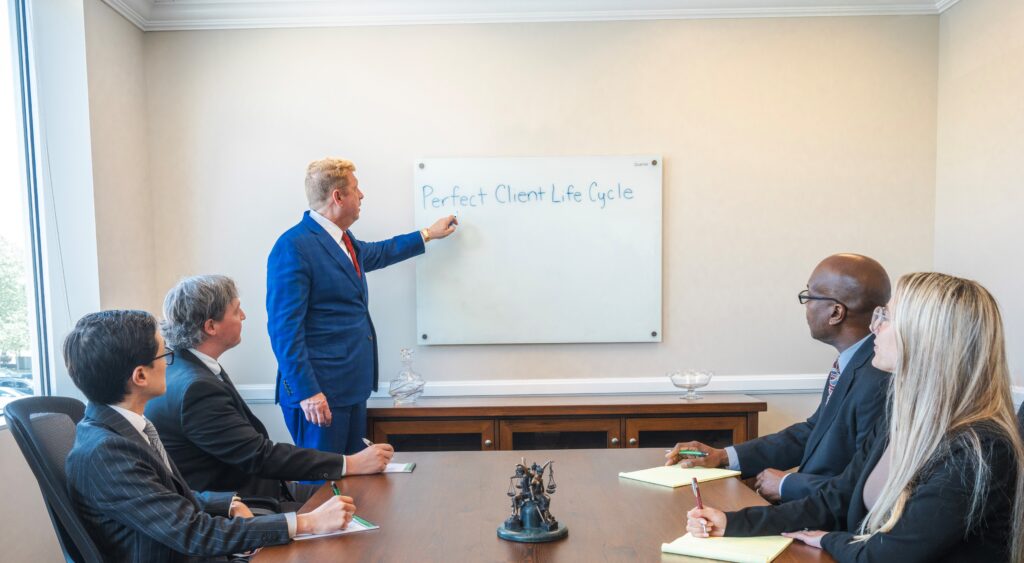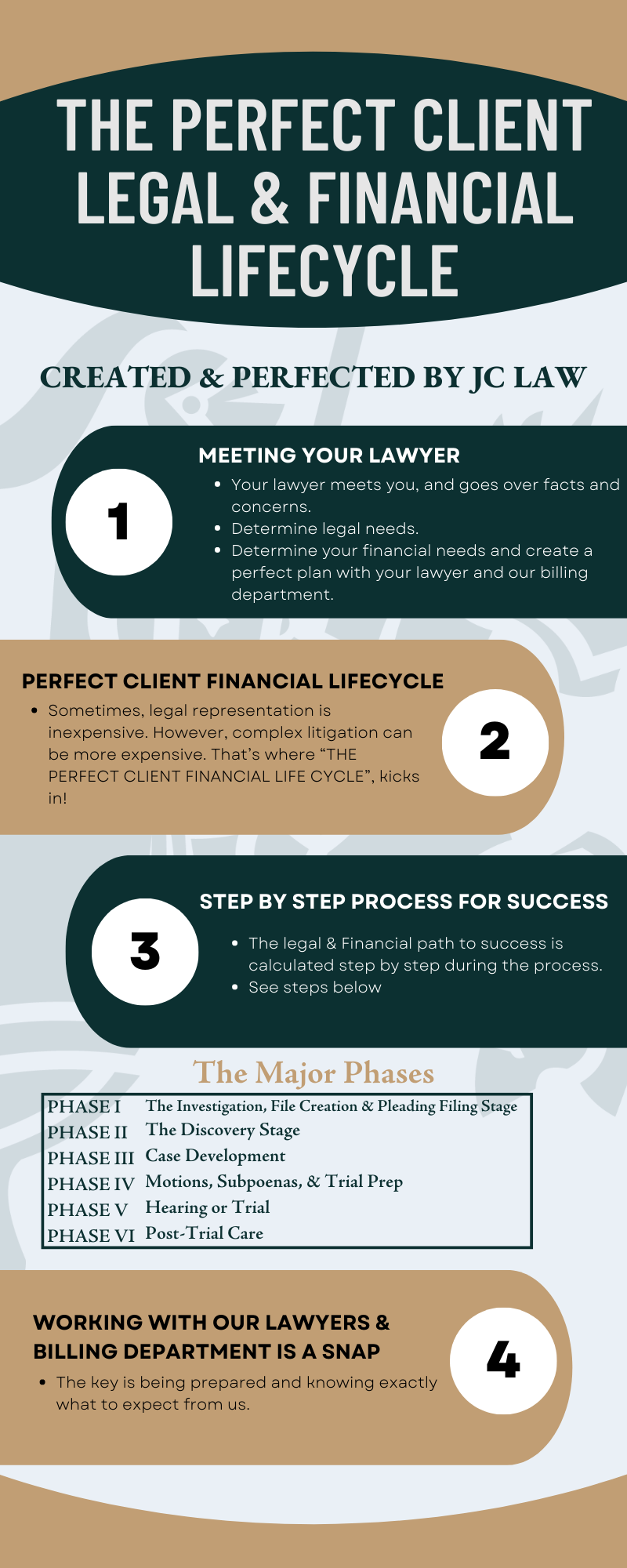Understanding JC Law’s PERFECT CLIENT LIFE CYCLE Matrix: A Comprehensive Guide

As a member of the JC Law team, I’m proud to share a core element of our approach: the PERFECT CLIENT LIFE CYCLE. This organic process, unique to JC Law, is designed to guide our clients through the complex financial stages of litigation while ensuring they are prepared and informed every step of the way. Our goal is to provide not only excellent legal representation but also financial clarity and peace of mind.
Our attorneys work closely with the Client Account Management group to ensure our clients can confidently manage the financial demands of their legal matters. Payment plans and proactive financial planning are at the heart of this process, empowering our clients to tackle their legal challenges without undue financial stress.
Each phase of the PERFECT CLIENT LIFE CYCLE is essential to navigating the complexities of a domestic case. Let’s break down the journey:
The “Fab 5”
Before diving into the phases, we establish the foundation:
- Sale: The initial consultation where we understand the client’s needs and they understand our services.
- File Created: A central repository, both physical and digital, for all case-related information.
- File Given to Team: Seamless handover to the dedicated legal team, ensuring continuity and efficient workflow.
Phase I: Gathering Info / Meet Client / Setting Up Case
This initial phase is all about laying the groundwork for a successful case. It’s about active listening, diligent fact-finding, and strategic planning.
- Automated First Steps: We immediately send out a universal cheat sheet to help clients gather essential information.
- Personalized Roadmap: As soon as a case is assigned, I personally call the client. I craft a detailed roadmap email outlining the next steps and promptly schedule an in-person meeting or Zoom call to analyze the case thoroughly.
- In-Depth Client Meeting: During this crucial meeting, I meticulously gather information about the case, paying attention to every detail. I begin building the case file system, organizing information specific to the nature of the case – witnesses, property, child support, financial data, etc. This system is maintained in both paper and digital formats and is constantly updated. I take copious notes, documenting the history of the client, all involved parties, and their respective family members. This is the time to gather all relevant contact information, including addresses and phone numbers. These meetings generally last at least an hour, sometimes up to four, depending on the case’s complexity. At the conclusion of the meeting, I send a follow-up email outlining the game plan and summarizing our discussion.
- Financial Transparency: I discuss the approximate cost of the case in detail, explaining the different phases and outlining when funds will be needed. The goal is to create a clear understanding of the financial commitment involved and remove any surprises. I take detailed notes on these conversations.
- Witness Identification: I gather comprehensive information on potential witnesses, documenting everything on a dedicated witness page.
- Strategic Organization: I meticulously organize the file and develop a preliminary plan of attack.
- “Top Memo” Creation: In addition to the roadmap email, I always prepare a “top memo” summarizing the nature of the case and its key elements. This memo outlines the legal and factual issues, ensuring anyone reviewing the file can quickly grasp the essence of the matter.
- Client Understanding Letter: I draft a letter to the client reiterating the key points discussed in the memo. This letter outlines the client’s goals, desires and our strategy for achieving them. I also explain the realistic limitations of what we can and cannot accomplish. I will also update the client with a new letter at each new stage of the case as well.
- Legal Research: I proactively research the relevant laws, printing out copies and creating a dedicated “Law” folder within the file. I include references to these laws in the memo or letter, where applicable.
- File Structure: I organize the file with the following folders:
- Financials: Includes a copy of the SASI (Support Analysis System of Information) financial assessment on every file. I provide the client with a preliminary SASI run and keep a copy in the file. I also provide the client with our comprehensive long financial form, with instructions to complete the form and provide all supporting documentation at our next meeting.
- Investigation
- MD Case Search: Includes printed copies of Maryland case searches, updated each time the file is accessed.
- Law Research:
- Basic Info File (including Retainer, etc.)
- Discovery
- Depositions
- Correspondence
- Billing
- Property
- Expectation Management: I discuss realistic expectations with the client, covering both legal and financial aspects. I also introduce them to the Billing Department.
- Diary Management: I immediately and diligently manage the diary to ensure deadlines and appointments are never missed.
- Financial Awareness: I always review the client’s financial situation, noting the amount in escrow and discussing any concerns with the client.
Phase II: Filing Stage & Follow Up
This phase marks the transition from planning to action, with the filing of legal documents and proactive follow-up.
- Second Financial Review: During the 2nd or 3rd meeting with the client, I review their financials in meticulous detail. The paralegal updates the long financial form with any new information and provides a second copy to the client. I also provide a second copy of the SASI report.
- Appointment Scheduling: Before the client leaves a Zoom meeting or our office, I always schedule the next appointment to ensure consistent progress.
- Continuous Review and Documentation: I consistently review the case and meticulously keep notes of any important developments.
- Pleadings Preparation: I prepare all necessary litigation pleadings with accuracy and attention to detail.
- Discovery Collaboration: I work closely with the Discovery Department to prepare comprehensive and tailored discovery requests, including all three modes of discovery.
- Client Review and Signature: I schedule an appointment for the client to review and sign the prepared documents. At this meeting, I discuss the progress of the case and any financial implications.
- Witness Interviews: I personally meet with all witnesses, or delegate to a clerk, to gather important information.
- Separation and Property Agreements: If applicable, I draft separation and property agreements.
- Proactive Subpoenas: I make it a habit to subpoena all relevant banks and employers, utilizing subpoena duces tecum, etc.
- Deposition Planning: I proactively plan for depositions.
- Non-Retainer Letters: I ensure that all necessary non-retainer letters have been sent.
- Diary Management: I diligently manage the diary to ensure deadlines and appointments are never missed.
Phase III: Financial & File Building Stage
This phase focuses on strengthening the financial foundation of the case and expanding the file with crucial documentation.
- Financials Deep Dive: This is the stage where I meticulously work on the financial aspects of the case. I ensure that the financial folder contains all applicable bills.
- SASI Collaboration: I email and call the client, guiding them in gathering all the necessary financial documentation for the SASI. I collaborate with them to list these documents, organize them, and prepare them for potential trial or other forms of evidence. The result is a perfected financial record, with a running summary sheet on top of the folder for quick reference.
- Subpoena Issuance: I issue all other relevant subpoenas, refusing to rely on others to do so. On average, each file should contain at least five subpoenas.
- Settlement Exploration: I actively explore potential settlement options by contacting opposing counsel or the opposing party.
- Hearing Preparation: I prepare for scheduling hearings, including a third meeting with the client to discuss dates and informational needs.
- Discovery Monitoring: I diligently check on the status of discovery. If deadlines have passed, I send friendly reminders to the opposing party, always copying the client on all correspondence. My aim is to be proactive in pursuing the client’s goals.
- Legal & Factual Issue Reinforcement I continue to analyze the legal or factual issues of the case.

These are the initial phases, the foundation for our client’s journey. I’ll continue the breakdown in the next message, exploring the remaining phases and the strategies we employ to achieve the best possible outcome for our clients.